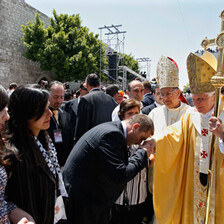The Electronic Intifada 17 May 2009
JERUSALEM (IPS) - Even as Pope Benedict XVI tried his best during his recent Holy Land visit to pay reverence to the attachment of all three monotheistic faiths to Jerusalem, on the ground a less lofty imprint is already furthering Israeli control over the Holy City in a way that could threaten the claims of all but Jews to Jerusalem.
The Israeli government is quietly implementing a development plan that aims at transforming the area known as the “Holy Basin” — land both inside and just outside the walled Old City — into a major “Biblical Kingdom,” the aim of which is to strengthen Israel’s hold over the whole of the city.
The $165 million eight-year design involves the creation of a series of nine national parks and tourist trails based on historical sites. Much of the plan has been put under the control of ultra-nationalist Israeli settlers groups who are simultaneously at the forefront of a land acquisition policy geared to taking over as many Palestinian homes in the area as possible.
The Palestinians of East Jerusalem which Israel occupied in 1967 make up a third of the city’s population.
Details of the confidential scheme have been propitiously exposed during the papal visit by Ir Amim, an Israeli civil society organization that advocates a shared Jerusalem.
“The plan constitutes a drastic change in the status quo in the city,” Ir Amim says, “the program is being sponsored secretly by the offices of the Israeli prime minister and of the Israeli mayor of Jerusalem. It is being advanced without any transparency or public debate. Neither heads of churches, Muslim religious authorities, nor the Palestinian residents and not even the Israeli public have been made aware of the plan.”
The development plan was quietly first agreed upon by the Israeli government in 2005 “to strengthen the status of Jerusalem as the capital of Israel.”
Implementation began in the last year. As part of the plan, garbage dumps and wasteland are being cleared and turned into gardens and parks. All along newly laid-out footpaths that take in the majestic views, new signs and displays are being put up to point out significant places of Jewish history. Collaterally, Israeli archaeologists are busy excavating to uncover evidence of the area’s “Jewish past.”
But the Holy Basin is a complex multi-layered religious landscape with shrines and still-hidden treasures belonging to the three religions. It includes several of the most famous Christian sites, such as the Garden of Gethsemane where the Pope on Tuesday celebrated Mass at the site where Jesus prayed the night before his crucifixion. An ancient Muslim cemetery right at the foot of the Mount of Olives, and adjacent to the Old City walls, is run by the Islamic religious endowment authority, the Waqf.
According to details of the plan made known to IPS, “The parks are located on public and private land and will be fenced in, which will mean the de facto transfer of land to the control of the Israeli settler organizations.” Together with the demolition of Palestinian homes planned in the neighborhood of Silwan adjacent to the Old City, the plan “will drastically decrease Palestinian presence in the area.”
The scheme is intended to create a green belt, but effectively a sovereignty belt, around the Old City. That could make it harder than ever to divide Jerusalem between Israelis and Palestinians in the context of a two-state solution. In 2000, months after the millennium visit of John Paul II, the fate of the Holy Basin was at the heart of the failed attempt at Camp David to negotiate the outlines of a two-state solution.
Daniel Seidemann, an Israeli lawyer and founder of Ir Amim, says the green belt would be linked up to existing and planned new Jewish settlements in east Jerusalem and the West Bank: “This will mean that territorial compromise would only be possible in the northern and southern parts of Jerusalem, beyond the area immediately surrounding the Old City. It fans the flames of the conflict and threatens to change this from a conflict of national claims that is controllable and solvable into a pointless regional confrontation.”
The battle for Jerusalem is often posited as a battle for historical legitimacy between Jews and Muslims. But since the Palestinian intifada uprising which erupted a few months after the last papal visit, Palestinian claims have been effectively neutralized. The Orient House, the informal headquarters of the Palestinian Authority in East Jerusalem, was closed down by Israel and has remained shut since.
Two months ago, even a modest Palestinian attempt to organize a cultural day highlighting Jerusalem as the center of Palestinian aspirations was prohibited by Israel. And just earlier this week, a press conference hosted by the Palestinian Authority about the implications of the Ir Amim report at an East Jerusalem hotel was abruptly ended by Israeli police.
The settler groups charged with carrying out the plan have refused to comment.
In response to the Ir Amim disclosure, the Israeli prime minister’s office issued this statement to reporters: “Jerusalem has been the eternal capital of the Jewish people for some three thousand years and will remain the united capital of the State of Israel. The government will continue to develop Jerusalem, development that will benefit all of Jerusalem’s diverse population and respect the different faiths and communities that together make Jerusalem such a special city.”
It is clear, however, that the focus of the plan is Jewish heritage, and that the spirit of the plan is being shaped by ultra-nationalist Israelis who stress exclusively Jewish religion and history to substantiate Israel’s claim even within Palestinian neighborhoods.
All rights reserved, IPS - Inter Press Service (2009). Total or partial publication, retransmission or sale forbidden.




